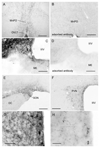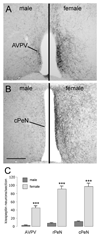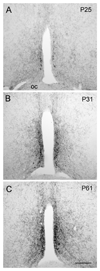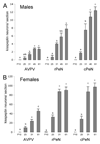Postnatal development of kisspeptin neurons in mouse hypothalamus; sexual dimorphism and projections to gonadotropin-releasing hormone neurons
- PMID: 16959837
- PMCID: PMC6098691
- DOI: 10.1210/en.2006-0787
Postnatal development of kisspeptin neurons in mouse hypothalamus; sexual dimorphism and projections to gonadotropin-releasing hormone neurons
Abstract
The neuropeptide kisspeptin has recently been implicated as having a critical role in the activation of the GnRH neurons to bring about puberty. We examined here the postnatal development of kisspeptin neuronal populations and their projections to GnRH neurons in the mouse. Three populations of kisspeptin neurons located in the 1) anteroventral periventricular nucleus (AVPV) and the preoptic periventricular nucleus (PeN), 2) dorsomedial hypothalamus, and 3) arcuate nucleus were identified using an antisera raised against mouse kisspeptin-10. A marked 10-fold (P<0.01), female-dominant sex difference in the numbers of kisspeptin neurons existed in the AVPV/PeN but not elsewhere. Kisspeptin neurons in the AVPV/PeN of both sexes displayed a similar pattern of postnatal development with no cells detected at postnatal day (P) 10, followed by increases from P25 to reach adult levels by puberty onset (P<0.01; P31 females and P45 males). This pattern was not found in the dorsomedial hypothalamus or arcuate nucleus. Dual immunofluorescence experiments demonstrated close appositions between kisspeptin fibers and GnRH neuron cell bodies that were first apparent at P25 and increased across postnatal development in both sexes. These studies demonstrate kisspeptin peptide expression in the mouse hypothalamus and reveal the postnatal development of a sexually dimorphic continuum of kisspeptin neurons within the AVPV and PeN. This periventricular population of kisspeptin neurons reaches adult-like proportions at the time of puberty onset and is the likely source of the kisspeptin inputs to GnRH neurons.
Conflict of interest statement
The authors have nothing to declare.
Figures






References
-
- Terasawa E, Fernandez DL. Neurobiological mechanisms of the onset of puberty in primates. Endocr Rev. 2001;22:111–151. - PubMed
-
- Ojeda SR, Skinner MK. Puberty in the rat. In: Neill JD, editor. Knobil and Neill's Physiology of Reproduction. 3rd ed. San Diego: Academic Press; 2006. pp. 2061–2126.
-
- Plant TM, Witchel SF. Puberty in nonhuman primates and humans. In: Neill JD, editor. Knobil and Neill's Physiology of Reproduction. 3rd ed. San Diego: Academic Press; 2006. pp. 2177–2230.
-
- Kotani M, Detheux M, Vandenbogaerde A, Communi D, Vanderwinden JM, Le Poul E, Brezillon S, Tyldesley R, Suarez-Huerta N, Vandeput F, Blanpain C, et al. The metastasis suppressor gene KiSS-1 encodes kisspeptins, the natural ligands of the orphan G protein-coupled receptor GPR54. J Biol Chem. 2001;276:34631–34636. - PubMed
-
- Muir AI, Chamberlain L, Elshourbagy NA, Michalovich D, Moore DJ, Calamari A, Szekeres PG, Sarau HM, Chambers JK, Murdock P, Steplewski K, et al. AXOR12, a novel human G protein-coupled receptor, activated by the peptide KiSS-1. J Biol Chem. 2001;276:28969–28975. - PubMed
Publication types
MeSH terms
Substances
Grants and funding
LinkOut - more resources
Full Text Sources
Other Literature Sources

